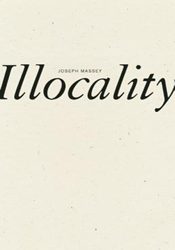
Illocality is Joseph Massey’s fourth book of poems since Areas of Fog appeared in 2009. His work in this volume is compact and philosophical and has already been included in more than one anthology. Poet Rae Armantrout compares Massey’s spare, concrete style to that of William Carlos Williams. And in a recent interview, Massey, in turn, compares his work to Armantrout’s!
No matter where the poet’s influences may originate, Massey is good company, offering us, as he does, the startling embrace of loveliness. His work is brave and contemporary. He finds beauty in the ever-changing moments of life. Consider the poem “Interim,” in which yellow caution tape, faded with the seasons, becomes almost sculptural. And read this line from the poem “Third Floor”: “Birdsong next door/slipknots construction noise.” See how the beauty is not in the thing itself, but in our perception of it?
In a recent interview with the journal Open House, Massey, who meditates daily, says that his Hindu studies draw him “into a more focused relationship with the world, such as it isn’t (it never is!)” In Illocality, mutable nature is a dominant presence. For example, “The Frame” breathes us into a scene that the window “lets in” and then “lets out.” Weather is “moving into/and out of” and sight “braces” the speaker of the poem “here—there”—We are centered, moving with these words as we inhale and exhale. We are grounded as we look at the horizon, another frame for the poem as it begins and ends with an image of the sky.
Most twentieth-century poets jettison weather as a subject rife with platitudes (in the tradition of nature verse that is vapid and naïve). Massey, on the other hand, revives weather as a valid poetic subject. Watch how “March Saturated” revisits mud season with a new vocabulary that deploys sharp visuals:
Ashen, angular
patches of ice
jut into so much
swamped geometry
It has been said that the power of Massey’s work lies in what is not said . This is the case with the image of “swamped geometry” as it conjures the idea of the cold water beneath the ice without mentioning water at all. We feel the freshness of the snowmelt—in language as new as every spring. He uses the present-progressive tense with its power to make things happen in the here and now. In this poem, he leaves us with “Gauzy sunburts/striping the thaw.”
Massey has also expressed how important sound is to his work—in fact, sound defines his work. “I’ve always aimed to make poetry that can sit on the page as a sculpture of sound first and foremost, everything else—whatever meaning is made and/or unmade—follows from that point.” Another poem in the collection, “April Talisman,” explodes with sound and images; this poem exemplifies the tools of the poetry trade at work. Sparse and elegant, the poem uses fewer than forty words. But each one is immaculately chosen, a vehicle for plosives, assonance, alliteration. Masterful line breaks allow each thought and to lift and fall, lift and fall. Listen:
Pluvial thrum of
peepers in the over-
growth above a
vernal
pool,
The title poem of the book also engages with nature. Writing from a room inside an old house, the speaker in the poem “Illocality” invites us to assess the world according to how we feel, not by how it has been measured. We are asked—
To imagine
the raw circumference
of a field
as it wakes
what we make of it
where our senses
send us
In other words, this poem asks us to trust ourselves—to eliminate the broker in the transactions between our senses and the natural world.
“The Span” is another example of a poem that, on first glance, offers a host of images. Massey gives us “a map,” “the quarry,” and “Broken glass horizon”— quotidian terms that let us free-associate to our own lives. A deeper analysis of this sixty-word poem takes the piece much further. It is dedicated to artist Nancy Holt.
Associated with the Land Art movement, Holt’s work broadens the mind into multidimensional perspectives. Her outdoor installation, “The Span,” incorporates a rotating metal grate reminiscent of the earth’s axis. Massey’s poem, which is broken into brief sections, also mentions “Sky-mound,” Holt’s piece that turned a New Jersey landfill into a living, breathing sculpture. It is designed to show that our trash can be transfigured into art, just as our trash can be recycled into methane fuel.
Nature, reinvented. An abundance of sound. Nimbly drawn images. The poetry of the environment. Massey gives us all of this, as he allows his poems to enter the world nearly naked, wearing only the moment itself.




